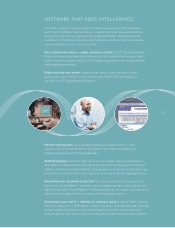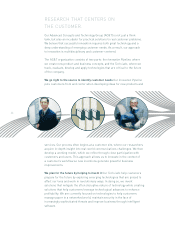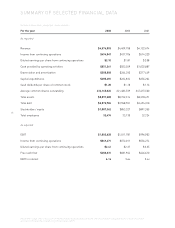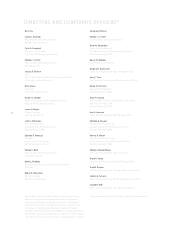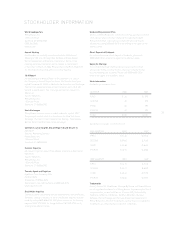Pitney Bowes 2003 Annual Report Download - page 29
Download and view the complete annual report
Please find page 29 of the 2003 Pitney Bowes annual report below. You can navigate through the pages in the report by either clicking on the pages listed below, or by using the keyword search tool below to find specific information within the annual report.
27
We achieved solid financial results in 2003. We met
our revenue, earnings and cash flow objectives,
and we substantially increased the company’s
financial flexibility in support of our growth
strategies. We also delivered a total return to
our shareholders of 28 percent, which consisted
of a stock price increase of 25 percent and our
dividend yield of 3 percent.
We grew our revenue by 4 percent to a total of
$4.6 billion. Favorable currency rates contributed
about 3 percent to our growth and were largely
responsible for strong growth in our international
operations (15 percent growth rate for non-U.S.
operations, compared with 1 percent in the U.S.).
Our revenue growth also was affected positively
by the acquisitions of PSI Group and DDD
Company, and negatively by our decision to
reduce our exposure to non-core financing.
On an “organic” basis (without the effects due
to currency and strategic actions), our revenue
growth rate was slightly positive for the year.
We met our earnings per share guidance
each quarter. Excluding “special items”
(e.g. restructuring charges, one-time write-offs)
our adjusted earnings per share from continuing
operations was $2.41 in 2003, compared with
$2.37 in 2002. If we exclude the impact of
non-core financing, our adjusted earnings grew
by 6 percent (from $2.13 to $2.25 per share).
On a GAAP basis, our earnings per share was
$2.11 in 2003, which compares with $1.97
in 2002. On page 29, we provide a reconciliation
between these GAAP numbers and our adjusted
results. The most significant special item during
2003 was an after-tax restructuring charge of
$75 million, which primarily reflects our actions
to outsource manufacturing and streamline
our infrastructure.
We generated over $850 million of cash from
operations and exceeded our target for “free
cash flow” (cash from operations less capital
expenditures). We also obtained over $300 million
of cash from our reduced investment in non-core
financing. As a result, we were able to increase
our dividend rate, repurchase $200 million of
common stock and reduce our total debt
outstanding by about $400 million.
We also restructured our debt to lengthen the
average maturity and to reduce our exposure to
potentially higher interest rates. As of the end of
2003, about 80 percent of our debt was long-term
and about 70 percent had a fixed interest rate.
As we look to 2004, we are optimistic about the
prospects for an improving global economy.
However, because of our relatively high percentage
of recurring revenue (about 77 percent in 2003),
we tend to lag the overall economy, and it generally
takes four quarters before we see the full effects
of an economic upturn in our results. In addition,
we will experience another year-over-year decline
in earnings from non-core financing, and we will
incur higher benefits and other non-controllable
expenses. However, while these factors will
constrain our earnings growth in 2004, we project
that they will have a lesser impact in future years.
We remain steadfastly committed to delivering
shareholder value and are confident that we
have the business model, growth strategies
and financial flexibility to make Pitney Bowes a
compelling investment for the foreseeable future.
Bruce Nolop
Executive Vice President and
Chief Financial Officer
FINANCIAL HIGHLIGHTS FROM OUR CFO








